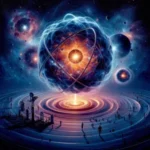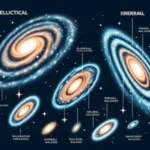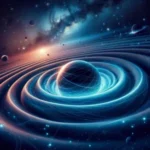As we gaze up at the night sky, the vast expanse of the cosmos invites us to ponder the mysteries that lie beyond our reach.
In the realm of modern astrophysics, one phenomenon stands out as a powerful tool for unlocking these cosmic secrets: gravitational lensing. This captivating effect occurs when a massive object, such as a galaxy or black hole, bends the light from objects behind it, acting like a cosmic magnifying glass. By studying these distorted images, astronomers can glean invaluable insights into the structure of the universe, the distribution of dark matter, and even the formation of distant galaxies. In this blog post, we will delve into the fascinating world of gravitational lensing, exploring how this extraordinary phenomenon not only enhances our understanding of the universe but also challenges our perceptions of space, time, and the very fabric of reality. Join us as we embark on a journey through the cosmos, revealing the intricate dance of light and gravity that shapes our celestial landscape.
1. Introduction to Gravitational Lensing
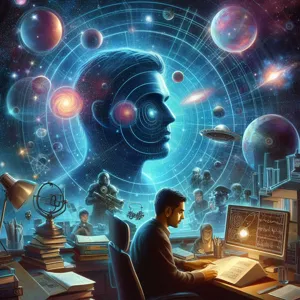
Gravitational lensing is one of the most fascinating phenomena in astrophysics, offering a unique window into the vast and complex universe that surrounds us. Imagine peering through a cosmic magnifying glass, where the light from distant stars and galaxies is bent and distorted by the immense gravitational pull of massive objects, such as galaxy clusters or black holes. This bending of light, a prediction of Einstein’s General Theory of Relativity, allows astronomers to observe objects that would otherwise remain hidden from our view, providing insights into the structure, composition, and evolution of the cosmos.
As light travels from distant celestial bodies, it often encounters massive gravitational fields that warp the fabric of space-time. The result is a stunning visual effect: distant galaxies appear as arcs, rings, or multiple images, captivating both scientists and stargazers alike. These optical illusions not only enhance our understanding of the universe’s architecture but also serve as powerful tools for measuring the mass of the intervening objects and exploring the mysterious dark matter that permeates our cosmos.
Gravitational lensing comes in three main forms: strong lensing, weak lensing, and microlensing, each offering different insights depending on the mass of the lensing object and the alignment of the source and observer. Strong lensing provides spectacular images of distorted light from distant galaxies, while weak lensing offers subtle clues about the distribution of dark matter through slight distortions in the shapes of galaxies. Microlensing, on the other hand, can reveal the presence of planets around distant stars, expanding our search for extraterrestrial worlds.
In this post, we will delve deeper into the mechanics of gravitational lensing, explore its various types, and highlight some groundbreaking discoveries that have emerged from this remarkable phenomenon. Through understanding gravitational lensing, we not only enhance our comprehension of the universe but also uncover the intricate dynamics of the celestial bodies that inhabit it. Join us as we embark on a journey through the cosmos, unlocking the secrets that gravitational lensing has to offer.
2. The Basics of Gravity and Light
To grasp the fascinating phenomenon of gravitational lensing, it’s essential to first understand the fundamental principles of gravity and light. Gravity, the invisible force that governs the motion of celestial bodies, is not merely a pull between masses; it is a curvature of spacetime itself, as described by Albert Einstein’s General Theory of Relativity. Imagine a trampoline stretched taut, with a heavy ball placed in the center. The weight of the ball creates a dip, causing smaller balls placed nearby to roll toward it. This visualization mirrors how massive objects, like galaxies or black holes, warp the fabric of spacetime, influencing the trajectory of light that passes nearby.
Light, on the other hand, is a stream of particles known as photons, traveling in straight lines through the universe at an astonishing speed of approximately 299,792 kilometers per second (186,282 miles per second). When light from a distant star or galaxy encounters a massive body, such as another galaxy or a cluster of galaxies, the gravitational field of that massive object bends the path of the light. This bending effect can amplify and distort the light, creating what we see as gravitational lensing.
In the cosmos, this lensing effect can produce mesmerizing visual phenomena such as arcs, rings, and multiple images of the same celestial object. These optical illusions not only captivate our imagination but serve as powerful tools for astronomers. By studying the light that has been bent, we can infer the presence of dark matter, measure distances in the universe, and even explore the distribution of galaxies. In essence, the interplay between gravity and light opens a window into the fabric of the universe, revealing secrets that would otherwise remain hidden in the vastness of space. Understanding these basics sets the stage for delving deeper into the complex and awe-inspiring world of gravitational lensing.
3. History of Gravitational Lensing: Key Discoveries
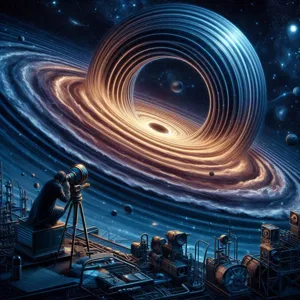
The story of gravitational lensing is a fascinating journey through the annals of astronomy, filled with groundbreaking discoveries that have reshaped our understanding of the cosmos. The concept itself dates back to the early 20th century, when Albert Einstein first proposed his theory of general relativity in 1915. This revolutionary framework suggested that massive objects, like galaxies and clusters of galaxies, could bend the fabric of spacetime, causing light from distant stars to curve around them. However, it wasn’t until 1936 that Einstein himself highlighted this phenomenon in a paper, predicting the existence of gravitational lenses.
The first significant observation of gravitational lensing came in 1979 with the discovery of a double quasar, known as Q0957+561. Astronomers noticed that the light from a distant quasar was split into two distinct images by the gravitational field of a foreground galaxy. This discovery provided a clear example of Einstein’s theory in action and opened the door to further investigations into the nature of light and gravity.
Over the following decades, advancements in telescope technology and imaging techniques allowed astronomers to identify more instances of gravitational lensing. The Hubble Space Telescope, launched in 1990, played a pivotal role in this exploration. Its high-resolution images revealed numerous gravitational lenses, including the striking case of the “Einstein Cross,” where a single galaxy acts as a lens to produce four separate images of a distant quasar.
As researchers delved deeper into the cosmos, they began to realize that gravitational lensing is not just a curious optical effect; it is a powerful tool for probing the universe’s most profound mysteries. By studying the way light is distorted by massive objects, scientists have gained insights into the distribution of dark matter, the expansion of the universe, and the formation of large-scale structures. The lensing effect has even enabled the discovery of exoplanets, as their gravitational influence can bend the light from distant stars.
With the continuous advancement of technology, including the upcoming James Webb Space Telescope, the potential for new discoveries in gravitational lensing is immense. Each new observation has the power to unlock additional secrets of the universe, reminding us that the cosmos is a vast and intricate tapestry, woven together by the interplay of light, gravity, and time.
4. Types of Gravitational Lensing: Strong, Weak, and Microlensing
Gravitational lensing is a fascinating phenomenon that occurs when a massive object, such as a galaxy or black hole, distorts the space around it, bending the light from objects behind it. This bending creates three distinct types of gravitational lensing: strong lensing, weak lensing, and microlensing. Each type provides unique insights into the universe and enhances our understanding of cosmic structures.
**Strong Gravitational Lensing** occurs when the foreground mass is exceptionally massive, creating a dramatic distortion of light. This often results in multiple images of the same astronomical object, forming arcs or even complete rings known as Einstein rings. Strong lensing is particularly valuable for studying distant galaxies and can reveal the presence of dark matter, as the lensing effect is a direct result of the mass distribution of the foreground object. By analyzing these striking images, astronomers can estimate the mass of galaxies and investigate their structure.
**Weak Gravitational Lensing**, on the other hand, involves more subtle distortions of light. In this case, the foreground mass is less concentrated, leading to slight changes in the shapes of background galaxies. Although these changes are difficult to detect with the naked eye, they can be quantified using advanced imaging techniques and statistical methods. Weak lensing provides crucial information about the large-scale structure of the universe, including the distribution of dark matter. By mapping these weak lensing effects across vast areas of the sky, scientists can create a detailed picture of how matter is distributed throughout the cosmos.
Lastly, **Microlensing** occurs when a relatively small mass, such as a star or planet, passes in front of a more distant light source. This type of lensing is characterized by brief, dramatic increases in brightness of the background object, as the foreground mass temporarily magnifies its light. Microlensing is especially noteworthy in stellar surveys, as it allows astronomers to detect objects that are otherwise too faint to observe directly. Furthermore, microlensing events have been instrumental in discovering exoplanets, providing evidence for their existence by observing the characteristic light curves produced during the lensing process.
Together, these three types of gravitational lensing unlock a treasure trove of information about the universe, revealing the intricate relationships between light, mass, and the cosmic structures that govern our reality. Through the lens of these phenomena, astronomers continue to deepen their understanding of the cosmos, shedding light on its most enigmatic and distant corners.
5. How Gravitational Lensing Works: The Science Behind the Phenomenon
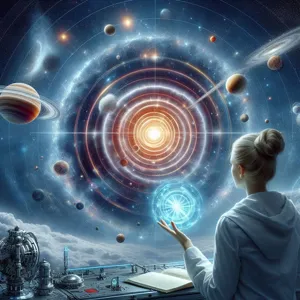
Gravitational lensing is a captivating cosmic phenomenon that occurs when a massive object, such as a galaxy or cluster of galaxies, bends the light from more distant objects behind it. Imagine a giant cosmic magnifying glass that distorts and amplifies the light coming from far-flung galaxies, allowing astronomers to peek into the deep reaches of the universe. This extraordinary effect is a direct consequence of Einstein’s theory of general relativity, which posits that massive objects warp the fabric of spacetime around them.
When light travels through this warped spacetime, it doesn’t follow a straight path. Instead, it curves around the massive object, creating a lensing effect that can lead to multiple images of the same distant galaxy, or even create arcs and rings known as Einstein rings. These visual phenomena occur because the bending of light can change the angle from which we observe the distant galaxies, offering us a unique view of their structure and composition.
The strength of the lensing effect is determined by the mass of the foreground object and the alignment of the observer, the lensing mass, and the background source. The closer the alignment, the more pronounced the lensing effect. Astronomers use sophisticated models to predict and analyze these alignments, allowing them to infer the mass of the lensing object, including dark matter, which is otherwise invisible.
This remarkable tool not only helps researchers study the distribution of dark matter in the universe but also enables them to observe galaxies that would otherwise be too faint or distant. By examining the light curves and spectral data of lensed objects, scientists can uncover vital information about the early universe, galaxy formation, and the nature of cosmic expansion. In essence, gravitational lensing transforms our understanding of the cosmos, revealing the hidden structures and intricate dynamics that shape the universe as we know it.
6. The Role of Dark Matter in Gravitational Lensing
Dark matter, the elusive substance that composes approximately 27% of the universe, plays a pivotal role in the phenomenon of gravitational lensing. Though it cannot be seen directly, its presence is inferred through the gravitational effects it exerts on visible matter, radiation, and the large-scale structure of the universe. When light from distant galaxies passes by a massive object, such as a galaxy cluster, dark matter contributes to the total mass of that object, enhancing its gravitational pull. This effect can bend and distort the light, creating the beautiful arcs and rings known as Einstein rings.
As scientists study these distortions, they are not only gaining insights into the behavior of light but also uncovering the distribution and density of dark matter itself. By mapping the gravitational lensing effects, astronomers can construct detailed maps of dark matter in galaxy clusters, revealing how it interacts with ordinary matter. This mapping provides crucial clues about the nature and properties of dark matter, helping to address one of the most profound questions in astrophysics: What is dark matter, and how does it shape our universe?
Moreover, gravitational lensing acts as a cosmic magnifying glass, allowing us to observe galaxies that would otherwise be too faint or distant to study. This is especially important when investigating the early universe, as the light from these ancient galaxies is stretched and amplified by the gravitational fields of intervening clusters. As a result, gravitational lensing not only deepens our understanding of dark matter but also opens new windows into the history and evolution of the cosmos itself, revealing the intricate tapestry of matter and energy that forms the universe we inhabit. Through this lens, both literal and metaphorical, we begin to piece together the cosmic puzzle, one gravitational arc at a time.
7. Gravitational Lensing as a Tool for Astronomy
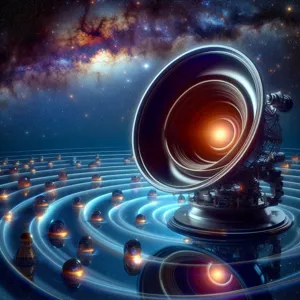
Gravitational lensing, a phenomenon predicted by Einstein’s theory of General Relativity, is not just a cosmic curiosity; it serves as a powerful tool for astronomers seeking to unlock the mysteries of the universe. When massive celestial bodies—such as galaxies or clusters of galaxies—interact with light from more distant objects, they warp the fabric of space-time, bending and magnifying the light that passes near them. This natural magnification allows astronomers to observe distant galaxies and cosmic events that would otherwise remain hidden from view.
The multifaceted applications of gravitational lensing are transforming the field of astronomy. For instance, it offers a unique method for measuring the mass of distant objects. By analyzing the light curves and distortions caused by gravitational lensing, scientists can determine the distribution of dark matter in galaxy clusters—an elusive component of the universe that does not emit light and has so far defied direct observation. This capability is crucial for piecing together the cosmic puzzle of how galaxies evolve and interact.
Moreover, gravitational lensing enables the study of the early universe. By focusing on lensed images, astronomers can glimpse the light from galaxies that formed billions of years ago, providing invaluable insights into the conditions that existed shortly after the Big Bang. These observations help to refine models of galaxy formation and the overall structure of the cosmos.
In addition to enhancing our understanding of the universe’s architecture, gravitational lensing serves as a testing ground for fundamental physics. It challenges our understanding of gravity and the nature of space-time, pushing the boundaries of knowledge in both astronomy and theoretical physics. As telescopes become more advanced and sensitive, the role of gravitational lensing in astronomical research will only continue to grow, offering new perspectives on the vast and enigmatic universe we inhabit.
8. Case Studies: Notable Examples of Gravitational Lensing
Gravitational lensing, a phenomenon predicted by Einstein’s theory of general relativity, has provided astronomers with invaluable insights into the structure of the universe. By studying the light from distant galaxies as it bends around massive objects, researchers have unlocked powerful case studies that illuminate the workings of the cosmos.
One of the most notable examples is the Hubble Space Telescope’s observation of the galaxy cluster Abell 2218. This cluster acts as a cosmic lens, magnifying and distorting the light from background galaxies. Hubble’s images reveal a mesmerizing array of arcs and multiple images of the same distant galaxies, showcasing how mass can warp space and enhance our view of the universe’s farthest reaches. The data gleaned from Abell 2218 has not only provided insights into the distribution of dark matter within the cluster but has also allowed astronomers to estimate the rate of expansion of the universe.
Another significant case is the observation of the galaxy cluster MACS J1149.5+2223, which has been pivotal in studying the early universe. In 2014, a supernova was observed in this cluster, and thanks to gravitational lensing, it was magnified to a degree that allowed astronomers to study its properties in unprecedented detail. This event, dubbed “The Lensed Supernova,” has opened new avenues for understanding stellar evolution and the chemical composition of the universe shortly after the Big Bang.
Moreover, the phenomenon of strong lensing has also unveiled the presence of exoplanets. The discovery of a planet around a star in the galaxy OGLE-2016-BLG-1195 was made possible through gravitational microlensing. As the planet passed in front of a more distant star, its gravitational field amplified the light from that star, creating a temporary brightening detectable from earth. This breakthrough has underscored the utility of gravitational lensing not just in cosmology, but in the search for distant worlds.
Through these compelling case studies, gravitational lensing continues to be a powerful tool in astrophysics, allowing scientists to probe the mysteries of dark matter, determine the rate of cosmic expansion, and even discover new celestial bodies. As our observational capabilities improve, the lensing effect will undoubtedly unveil even more secrets of the universe, deepening our understanding of the cosmos and our place within it.
9. The Impact on Our Understanding of Galaxies and Galaxy Formation
Gravitational lensing, a phenomenon where massive objects like galaxies bend the fabric of space-time, has profound implications for our understanding of galaxies and their formation. When light from a distant galaxy passes near a massive foreground galaxy, the intense gravitational field warps the light path, magnifying and distorting the image of the background galaxy. This cosmic trick not only allows astronomers to observe galaxies that would otherwise be too faint or too far away, but it also provides a unique window into the complex processes that govern galaxy formation and evolution.
Through gravitational lensing, scientists have been able to peer deeper into the universe’s history, unveiling galaxies that formed within the first billion years after the Big Bang. These observations challenge our existing models of galaxy formation, suggesting that the early universe was a bustling environment filled with nascent galaxies merging and interacting in ways previously unseen. The details captured through lensing reveal the diverse structures and compositions of these distant galaxies, offering clues about how they assembled and evolved over time.
Moreover, gravitational lensing plays a critical role in mapping the distribution of dark matter in the universe. By analyzing the degree of distortion in the light from lensed galaxies, astronomers can infer the presence and concentration of dark matter surrounding foreground galaxies. This information is essential for understanding the overall mass distribution in the universe and the role dark matter plays in galaxy formation.
As we continue to refine our techniques and tools for observing gravitational lensing, the insights gained are reshaping our understanding of the cosmos. Each new discovery adds a piece to the puzzle of how galaxies form, interact, and evolve, ultimately transforming our view of the universe’s grand tapestry. Gravitational lensing not only helps us uncover the hidden structures of galaxies but also deepens our appreciation for the intricate and dynamic processes that have shaped the universe we inhabit today.
10. Gravitational Lensing and the Search for Exoplanets
Gravitational lensing, a captivating phenomenon where massive celestial bodies bend the light from objects behind them, has opened up new avenues in the quest to discover exoplanets—planets that orbit stars outside our solar system. Traditionally, exoplanet detection has relied on methods such as the transit method, where astronomers observe the dimming of a star as a planet passes in front of it, or radial velocity, which measures the star’s wobble due to gravitational pulls from orbiting planets. However, these techniques often have limitations, especially for distant stars.
Enter gravitational lensing as a game-changer. When a massive object, like a galaxy or a cluster of galaxies, lies between Earth and a distant star, its gravitational field acts like a lens, magnifying and distorting the light from the star. This effect can reveal not only the star’s properties but also the presence of any orbiting exoplanets. As the light from the distant star is bent, it can create multiple images, arcs, or even a ring-like structure known as an Einstein ring, depending on the alignment of the lensing object and the background star.
What makes gravitational lensing particularly exciting is its ability to detect exoplanets that may be too faint or distant for conventional methods. By analyzing the light curves produced during lensing events, astronomers can identify the slight variations caused by the gravitational influence of an exoplanet. This method offers a unique perspective, allowing scientists to explore a diverse range of planetary systems that might otherwise remain invisible.
Moreover, gravitational lensing provides insights into the distribution of dark matter, as the lensing effect reveals how mass is distributed in the universe, including the elusive dark matter that does not emit light. By combining the knowledge gained from lensing with other observational techniques, researchers are piecing together a more comprehensive picture of how planets form and evolve in various cosmic environments.
In summary, gravitational lensing is not just a fascinating cosmic trick of light; it is a powerful tool enhancing our ability to locate and understand exoplanets. As we continue to refine our techniques and technology, the universe may have many more secrets waiting to be unveiled through the lens of gravity.
11. Future Prospects: Upcoming Missions and Technologies
As we stand on the brink of a new era in astrophysics, the future prospects for gravitational lensing research are nothing short of exhilarating. Upcoming missions and cutting-edge technologies promise to enhance our understanding of the universe in ways we can only begin to imagine.
One of the most anticipated missions is the **James Webb Space Telescope (JWST)**, which, having already begun its journey of exploration, is poised to revolutionize our perception of the cosmos. With its unprecedented sensitivity and ability to observe in infrared wavelengths, JWST will allow scientists to analyze gravitationally lensed objects with an astonishing level of detail. This means sharper images of distant galaxies, clearer views of the early universe, and a deeper understanding of dark matter’s role in cosmic structure formation.
In tandem with JWST, the **Euclid Mission**, set to launch in the near future, promises to map the geometry of the dark universe with remarkable precision. By leveraging gravitational lensing, Euclid will survey billions of galaxies to probe the effects of dark energy and dark matter, revealing the hidden forces that shape our universe. This mission aims to provide insights into the distribution of mass in the universe, helping to refine our models of cosmological evolution.
Moreover, advancements in ground-based observatories, such as the **Giant Magellan Telescope (GMT)** and the **Thirty Meter Telescope (TMT)**, are also on the horizon. These colossal instruments will enhance our ability to capture and analyze the subtle distortions caused by gravitational lensing, allowing astronomers to study the formation and evolution of galaxies with unprecedented clarity.
Technological innovations, such as improved algorithms for data processing and machine learning techniques, will further accelerate the pace of discoveries. These tools will enable researchers to sift through vast datasets more rapidly, identifying gravitational lenses and their properties with greater accuracy than ever before.
As we look to the future, the synergy between these pioneering missions and technologies will not only deepen our understanding of gravitational lensing but also illuminate fundamental questions about the nature of the universe itself. With each new finding, we are likely to uncover more about the cosmic tapestry, revealing the intricate connections between light, gravity, and the very fabric of reality. The journey promises to be as awe-inspiring as the discoveries themselves, bringing us ever closer to unlocking the secrets of the cosmos.
12. The Broader Implications of Gravitational Lensing on Cosmology
Gravitational lensing, the phenomenon where massive objects like galaxies bend the light from more distant celestial bodies, offers profound implications that extend far beyond mere images of distorted stars. For cosmologists, it serves as a powerful tool that enhances our understanding of the universe’s structure, composition, and evolution.
One of the most significant implications of gravitational lensing is its ability to reveal the presence of dark matter, an elusive substance that makes up about 27% of the universe yet remains invisible and undetectable by conventional means. By studying how light is bent around massive clusters of galaxies, scientists can map the distribution of dark matter with remarkable precision. This not only helps to validate the existence of dark matter but also provides insights into its properties and behavior.
Moreover, gravitational lensing plays a crucial role in measuring the expansion rate of the universe. By observing lensed objects known as “multiple images,” which are essentially the same astronomical event seen from different angles, researchers can determine distances to faraway galaxies with greater accuracy. This is essential for refining measurements of the Hubble constant, a key parameter that describes how fast the universe is expanding. Discrepancies in these measurements have led to ongoing debates in cosmology, and gravitational lensing may help resolve these differences by providing a more consistent framework for distance measurements.
Additionally, gravitational lensing opens a window into the early universe, allowing astronomers to study the formation of galaxies and structures shortly after the Big Bang. By observing lensed light from ancient galaxies, we can glean information about their formation and evolution, offering a glimpse into the conditions that shaped the cosmos we see today.
In summary, the broader implications of gravitational lensing on cosmology are profound and far-reaching. It not only helps to unravel the mysteries surrounding dark matter and the expansion of the universe but also enriches our understanding of cosmic history. As technology advances and observational techniques improve, gravitational lensing will undoubtedly continue to transform our comprehension of the universe, helping us unlock the secrets of the cosmos that have puzzled humanity for centuries.
13. Common Misconceptions About Gravitational Lensing
Gravitational lensing is a fascinating phenomenon, yet it is often shrouded in misconceptions that can cloud our understanding of its implications for cosmology. One of the most prevalent myths is that gravitational lensing is merely an optical illusion. While it is true that this phenomenon creates stunning visual distortions, such as arcs and rings of light, it is far more than just a trick of the eye. Gravitational lensing occurs because massive objects, like galaxies or galaxy clusters, warp the fabric of spacetime around them, bending the light from more distant objects. This bending can actually reveal crucial information about the mass and distribution of the lensing object, providing astronomers with a unique tool to explore the universe.
Another common misunderstanding is that gravitational lensing only occurs with extremely massive objects. While it is true that the most dramatic examples of lensing involve giant galaxy clusters, smaller-scale lensing can occur with individual galaxies and even stars. This means that researchers can study a variety of cosmic structures and phenomena through lensing effects, broadening the scope of what we can learn about both dark matter and the distribution of galaxies across the universe.
Additionally, some people believe that gravitational lensing is a rare occurrence, but in reality, it is quite common. As light travels across the vast distances of space, it often encounters massive objects that exert their gravitational influence, resulting in lensing effects that we can observe from Earth. This omnipresence opens up a wealth of data, allowing scientists to study the universe’s structure, the behavior of dark matter, and the expansion of the cosmos itself.
Understanding these misconceptions is vital for appreciating the true power of gravitational lensing. As we continue to unlock its secrets, we gain deeper insights into the universe’s past, present, and future, reshaping our cosmic narrative in profound ways. By debunking these myths, we pave the way for a more accurate and nuanced understanding of one of the universe’s most intriguing phenomena.
14. How You Can Observe Gravitational Lensing
Observing gravitational lensing may seem like a task reserved for astronomers with high-powered telescopes and sophisticated equipment, but excitingly, there are ways for amateur enthusiasts to participate in this cosmic phenomenon. Gravitational lensing occurs when a massive object, like a galaxy or cluster of galaxies, distorts the light from a more distant object, acting as a cosmic magnifying glass. This remarkable effect can reveal information about celestial bodies and help us understand the universe’s structure and evolution.
To start your journey into observing gravitational lensing, you don’t necessarily need a professional-grade telescope. Begin with a good quality telescope or even a pair of binoculars. Familiarize yourself with the night sky by using astronomy apps or star charts to locate distant galaxies and galaxy clusters. The Abell 1689 galaxy cluster, for instance, is a well-known gravitational lensing target that can be observed through amateur telescopes under dark skies.
Once you’ve identified a target, look for the telltale signs of gravitational lensing: light arcs or distorted images of background galaxies. These arcs are the result of light being bent around the massive foreground cluster. Take your time to study the images, as they often reveal multiple images of the same object, a striking reminder of the universe’s intricate dance of light and gravity.
For those unable to access telescopes, participating in citizen science projects such as the Galaxy Zoo can be a rewarding alternative. These initiatives allow you to analyze images of galaxies and help identify lensing events by classifying galaxy formations, contributing to valuable research while honing your observational skills.
Finally, consider joining local astronomy clubs or online forums where you can share your findings and learn from seasoned astronomers. Engaging with a community can deepen your understanding of gravitational lensing and keep you inspired as you explore the cosmos. With patience and curiosity, you too can unlock the secrets of the universe through the mesmerizing lens of gravitational lensing.
15. Conclusion: The Ongoing Journey of Cosmic Discovery Through Gravitational Lensing
As we conclude our exploration of gravitational lensing, it becomes evident that this phenomenon is not merely a scientific curiosity; it is a powerful tool that continues to reshape our understanding of the cosmos. The ongoing journey of cosmic discovery, propelled by the bending of light around massive celestial objects, reveals a universe that is far more complex and intertwined than we could have ever imagined.
Gravitational lensing provides a unique window into the distant and often obscured realms of the universe, allowing astronomers to observe galaxies and cosmic structures that would otherwise remain hidden from our view. With each new observation, we unveil the mysteries of dark matter, the formation of galaxies, and the expansion of the universe itself. The data gleaned from these lensing events not only enhances our knowledge of the cosmos but also raises new questions that drive the quest for understanding even further.
As technology advances, so too does our capability to harness the power of gravitational lensing. Future telescopes equipped with cutting-edge instrumentation will enhance our ability to probe deeper into the fabric of space-time, capturing even fainter light from the earliest galaxies. This will undoubtedly lead to groundbreaking discoveries, further illuminating the nature of dark energy and the very origins of the universe.
In essence, the journey of cosmic discovery through gravitational lensing is a testament to human curiosity and innovation. It challenges us to look beyond the visible, to question what lies beneath the surface, and to embrace the unknown. As we stand on the precipice of new astronomical frontiers, we are reminded that the universe, with all its complexities and wonders, continues to beckon us to explore, learn, and marvel at the intricacies of existence. The story of gravitational lensing is far from over; it is merely a chapter in the grand narrative of our quest to unlock the cosmos.
In conclusion, gravitational lensing serves as a powerful tool that not only deepens our understanding of the cosmos but also expands the horizons of astronomical exploration. By bending the light from distant galaxies, this fascinating phenomenon allows us to glimpse the hidden structures and dark matter that shape our universe. As we continue to unlock the secrets of gravitational lensing, we open the door to new discoveries, from the nature of dark energy to the formation of galaxies. The implications of this research are profound, promising to enrich our knowledge of the universe and challenge our perceptions of reality itself. As we gaze into the depths of space, let us remain curious and inspired, ready to embrace the wonders that await us in the ever-expanding cosmos.


